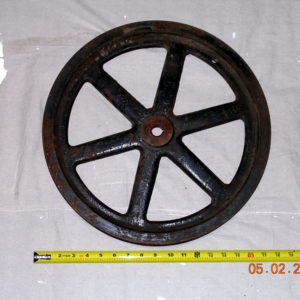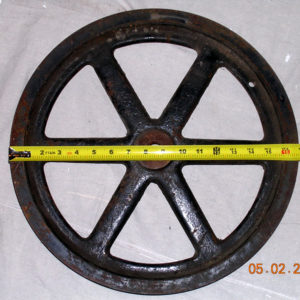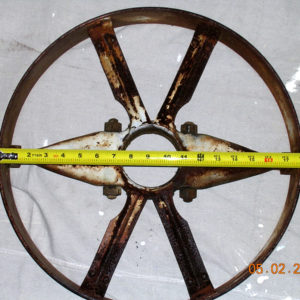Antique oversized bandsaw parts
I recently picked up a Crescent 26″ bandsaw built in 1916, that I will be restoring and putting back into service in my shop. The saw was built in Leetonia, OH under the Crescent Machine Co., and I date it at 1916 because of the new optional blade guards – thick wire cages in front of each wheel, and the fact that it does not have a motor, but instead has a tight and loose pulley attached to the lower wheel axle. These were driven via an overhead flat belt that was most likely powered by a steam engine or water wheel.
Everything about this saw is oversized and made of cast iron. As an example, the trunion release lever is 9″ long and is as thick as a quarter ($.25). The original tight/loose pulleys are 18″ in diameter. The more updated four belt sheave that I will be replacing the pulleys with is over 17″ in diameter (I will be milling out the center to accommodate the larger axle). To give some perspective – the lower wheel axle is almost 2″ thick and over 26″ long! Almost everything is cast iron, and fully assembled, this saw weighs almost 700 lbs. The body and upper wheel arm were fabricated as one giant iron casting.
I neglected to take pictures of the bandsaw before I stripped it down to its bare frame, but I have enclosed a couple of photos of some various parts.
This Friday I will be picking up a 16″ jointer from the same gentleman I purchased the saw from.
Dan Kornfeld, Owner/President – Odyssey Wood Design, Inc.
Edited 5/3/2005 1:29 am ET by Jackie Chan
Edited 5/3/2005 1:32 am ET by Jackie Chan
Edited 5/3/2005 1:33 am ET by Jackie Chan


















Replies
You may be able to get good results boring out, and turning down the arbor, but I would be tempted to go with a new bushed bore sheave while leaving the arbor diameter at 2". From WW Graingers a 3 belt 14 - 19" is $145. They are easy to put on and take off with no slop due to the tapered bushing.
Sure you don't want to send that 16" jointer to me? Is it the same vintage? I have replaced the bushings on a couple of 12" models with pillow blocks. That is usually an easy upgrade.
"Sure you don't want to send that 16" jointer to me? Is it the same vintage? I have replaced the bushings on a couple of 12" models with pillow blocks. That is usually an easy upgrade."
The jointer is of the same vintage, although I haven't been able to date it yet. It has the same flat belt pulleys that the bandsaw has.
Both machines have Babbit bearings. I've poured these before - it's not too difficult, and the Babbit metal and retaining compound is readily available from places like McMaster-Carr. I'll most likely pour new ones to avoid any unnecessary machining of original parts. Dan Kornfeld, Owner/President - Odyssey Wood Design, Inc.
Dan:
I'm sure it weighs more than 700lbs. My Cresent Heavy 20" tips the scale at 883lbs. All cast iron except the wheel doors their aluminum. I installed a 3hp Baldor with a variable pitch scheve to dial in the blade speed to 3960 sfpm. Run vibration free and slices 12' thick maple like a hot knife through melted butter. Paid $500 at auctin and about $200 more for the rebuild. Much said for older iron that the that the "neeeeewbeeees" don't understand. Most have Grizzly on their brain.
DJK
"I'm sure it weighs more than 700lbs..."
I wouldn't doubt it. The saw was loaded into the back of the pickup using the load lifting crane on the back of a work truck. The only way I got the saw off of the truck was to disassemble it right there in the truck bed! Even with the saw down to its bare casting, it still took a huge effort to get in onto the ground. The wheel guards and their frames are made out of steel and iron - and these were the light parts.Dan Kornfeld, Owner/President - Odyssey Wood Design, Inc.
I have a 26" Silver bandsaw in the process of being restored. I read that Cresent made this bandsaw for Silver. The two companies were only about 5 miles from each other. Do you plan to use conventional bearings vs babbit? I am leaning toward sealed bearings for any of the motor drive, in addition to a new induction motor. My BS is about the same vintage as yours, maybe even a few years older, it had a combination of metal screen guards and sheet metal drive enclosures, but they are pretty beat up as you can imagine. If you care to exchange ideas or anything related to the units let me know. I am always looking for new ideas and better ways to get things done. Joe.
Joe,
I'm actually planning to re-pour new Babbit bearings using a tin based Babbit material. The tin type is used for high speed applications. It does take higher heat (750 degrees) to melt the tin based material, and it costs a little more, but the bonus is that if you mess up the new pour, you can heat it with a torch, melt it out, and start again. Plus the retaining compound can be reused in some cases.
When you change over the flat belt pulleys to a more modern sheave, choose one with at least three belt positions. This will dramatically lessen the chances of the belt slipping, especially under start up.
If your saw is in less than perfect condition, you may notice what appears to be the casting flaking away. When these saws were manufactured, instead of grinding and smoothing the metal casting of the body, they used body filler (precursor to Bondo). If you strip the saw down to bare parts, it would be a good time to remove any loose body filler and replace it with a strong coat of Bondo - just do this in a ventilated area! Then you can sand the machine smooth, prime and repaint it.
If you have any questions, please feel free to ask!Dan Kornfeld, Owner/President - Odyssey Wood Design, Inc.
At one point about a year and a half ago my BS was almost completely restored, and at that point I had redone the babbits as well. The original ones weren't too bad to begin with, but I wanted to have the maximum life enhacement in any of the areas of restoration as I could so I repoured them. I know what you mean about the castings having weird filler. Mine had some sort of heavy primer undercoat in general, under that depending on the size of the blemish it was either leaded or a peice of steel was "threaded" and twisted into the hole then ground and leaded after. I went down to bare casting, even ground the inside of the base of the casting. I make my own epoxy based filler and used it to fill voids and the pores of the casting in general then used a epoxy enamal called "armour-poxy". The paint scheme was dark green for the general casting, red for the inside of the casting, with the wheels and most of the moving parts either satin black or clearcoted. I was and still am intending to use multi-belt sheaves likely with powertwist link belt instead of v belt. I had a slight set back in my restoration schedule due to my shop burning down summer before last. My bs was a victim in the fire but most of the damage to it is repairable, the babbits melted out so this time I am going to use big flange/pillow blocks that have grease zerks.If you are wondering what caused my fire, as far as I can tell it was caused from a Drillmaster 14.3v battery that was on it's charger plugged into the only plug that was left in the shop since I had removed all wiring and insulated and sheathed the inside. In thre rubble I found the battery pack with the batteries all strung out like a stretched out coil spring. The charger did not have an auto shut off timer like they all do now. I believe it may have been initiated by some sort of power surge since the PGE guy was the first to arrive at my house and I live in a very rural area. (I thought he was with the fire guys until they asked him who he was later....) anyway FYI that is what happened I think.Good luck with your Crescent, let me know if there is any other specifics from my restoration I can help you with and thanks for the quick reply as well. Joe.
If you haven't already found it, check out the Old Woodworking Machines website; http://www.owwm.com/. Lots of information and expertise there. I bet you'd find someone interested in the lineshaft pulley assembly too.
I know the owwm.com site well. I'm going to hold onto the original flat belt pulleys (I tend to not get rid of machines or machine parts) if I ever feel the need to make a 100% original parts restoration.Dan Kornfeld, Owner/President - Odyssey Wood Design, Inc.
This forum post is now archived. Commenting has been disabled